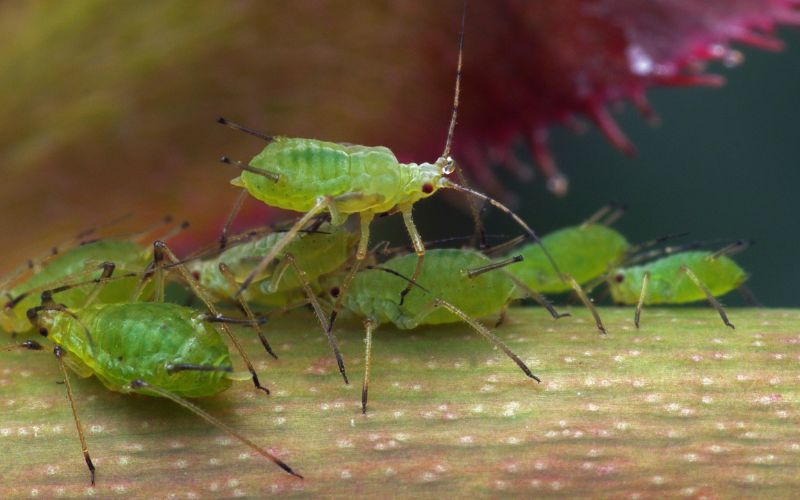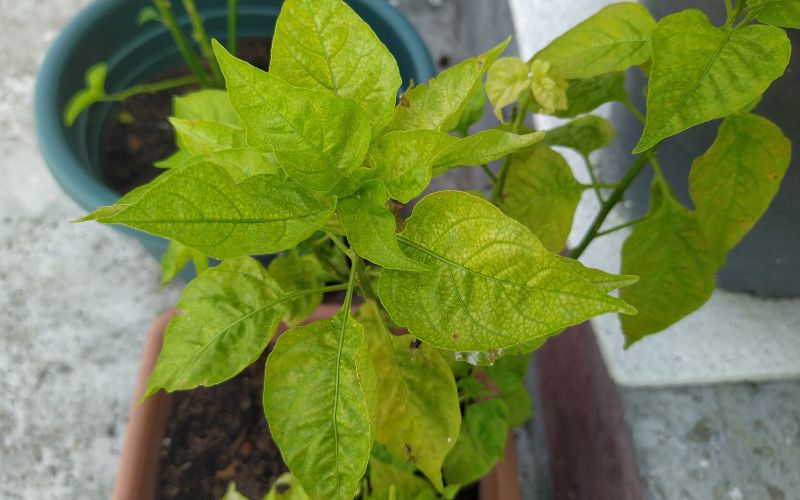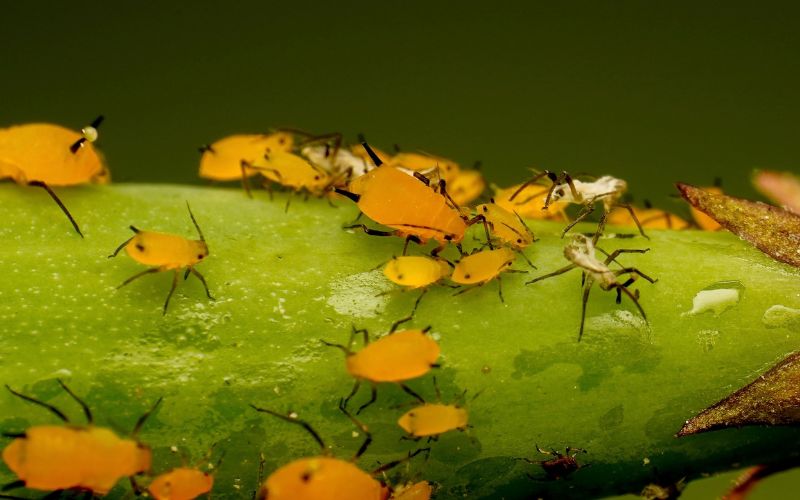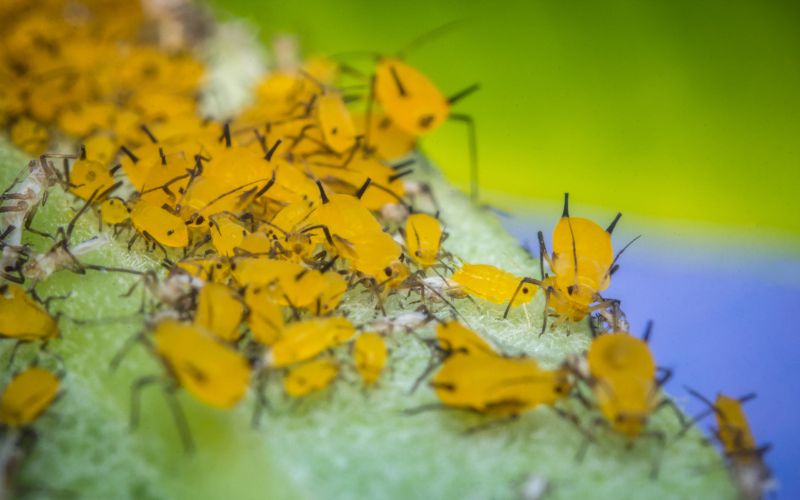Aphids are a common sight on plants and typically don’t cause noticeable damage in small numbers. In a healthy vegetable garden, their populations are kept in check by beneficial insects like ladybugs, which happily feast on these little pests.
However, when plants are stressed, aphids can quickly multiply and become a nuisance. In large numbers, these tiny sap-suckers can wreak havoc through the damage that they cause, which can lead to other plant-related issues.
That’s why it’s crucial for vegetable gardeners to be able to identify aphids and spot signs of an infestation. By detecting the problem early, you can take swift action to get rid of them with less effort. In this blog post, we’ll go deeper into the signs of aphids that you need to look for and what to do to get rid of them to keep your vegetable plants healthy and producing well.
What do aphids look like?
Aphids are small pear-shaped plant-sap-sucking insects that are closely related to whiteflies and scale insects. They come in a range of colors, including green, black, gray, pink, or white with a fluffy coat. They are commonly known as greenflies and blackflies but color can’t be used to identify them because the same species can come in different colors.

They come in both winged and wingless forms. Winged forms usually appear when host plants are crowded and aphids need to find another source of food so must move to another plant.
All aphids have two tubular projections, which are known as cornicles on their rear end. Aphids use their cornicles to secrete pheromones that defend them against predators. Cornicles can be easily identified in some species but are not easily visible in other species and winged forms.

Where are aphids found on plants?
Aphids are usually found clustered on plant parts that they are sucking sap from. Like many other pests, they like to remain under leaves for protection from predators and from the wind, rain, and sun. Aphids are also common on the growing tips of plants as well as flowers and fruits.

What direct damage do aphids do to plants?
Aphids pierce plant stems and veins to suck out sap from the phloem of plants. The phloem contains nutrients produced by photosynthesis in leaves. When a large number of aphids suck out the nutrients, the leaves, and stems of the plant become wilted and distorted due to a lack of nutrients. Eventually, the leaves and growing tips turn yellow and fall off.

What are the signs of aphids that I should look out for?
Since aphids are barely visible to the naked eye, especially if you’re a new gardener who isn’t familiar with how they look, some other easy-to-spot signs can tell you if there are aphids on your plants.
1. Ants gathered around the clusters of aphids
Ants and aphids have an interesting connection. The ants “farm” aphids because they enjoy feeding on the honeydew these little pests produce. To ensure a steady supply of honeydew, ants protect aphids from predators and parasites, making it quite challenging to control the aphids. The ants can even transport aphids from plant to plant spreading an infestation.

On the other hand, because ants are larger and more easily visible than aphids, ants can signal the presence of aphids on your vegetable plants. Spotting a trail of ants that are seemingly motionless and clustered on the underside of a leaf or the growing tips of your plants is a clear indication of an aphid infestation.

Read more on the association between ants and aphids
2. Damages to the plant
The sap-sucking by aphids leaves a mottled yellow pattern on plant leaves. The leaves and other growing tips aren’t able to grow properly due to nutrients being sucked out. This creates a curled and uneven growth of leaves.

3. White cast skins left on leaves
Aphids have complex life cycles, which can differ slightly between different species of aphids. In general, once the eggs hatch, immature nymphs that look similar to an adult emerge. These immature nymphs molt or shed their skin 4-5 times. The skin that they shed is white in color and is left on the leaves. The white skin casts may look like whiteflies from far so you should take a closer look.

4. Honeydew on leaves
The main component in plant sap is sugars and many of the sugars are ingested by aphids and the excess is passed out. These secretions, which are commonly referred to as honeydew, are sticky and are left on leaves. Honeydew can create additional problems as we will see below.

5. Leaves and stems that look like they have been speckled or coated with a thin black film
The substance that can be seen on leaves and stems, which makes it appear that they have been speckled or coated with a thin black film is black sooty mold, a type of fungi. This type of fungi can be wiped off from the leaf surfaces as it does not directly injure the plant but may reduce the amount of photosynthesis and with it, plant growth.
The growth of the fungus can be stopped by controlling the insects that are secreting the honeydew. If the affected plant doesn’t have an insect problem, the honeydew could be falling off from another plant above it.
How to get rid of aphids?
Once you have determined that your plants have aphids on them, it’s time to get to work and get rid of them.
A few aphids feeding on your plants will not be able to directly cause much damage but they can indirectly kill your plant. This is because aphids can inject plant viruses into the plant as they pierce the plant with their mouthparts to suck out the sap. This makes it important to get rid of aphids as soon as possible.
You should observe your plants for signs of aphids and other plant problems at least twice a week. Look closely under plant leaves where aphids and many other plant pests hide.
The first line of defense is spraying the affected plants with a high force of water to knock aphids off the plant. This must be repeated once a day for a couple of days until aphids are no longer visible. If you just have a couple of plants that are infected, repeating the same for a couple of days should be enough to get rid of an infestation.
Mechanically reducing the number of aphids on your plants will help common predators, such as ladybugs, hoverflies, and big-eyed bugs, as well as the aphid midge, a small long-legged fly that feeds only on aphids, control aphid populations better. Growing nectar-rich plants with small flowers, such as dill, parsley, and, yarrow will help attract these predators into your garden so that they can swing into action asap.

If the aphids are protected by ants, you can spray a homemade pest spray, such as garlic or hot pepper spray, or dust your plants with dichotomous earth. These remedies should get rid of both the aphids and the ants.
If you have tried all the options above and the aphid infestation still doesn’t seem to get better, you can use insecticidal soap or neem oil as a last resort.
As a vegetable gardener, knowing how to identify signs of aphids on your plants and how these signs are related to the activity of aphids will help you to easily get rid of aphids. Getting rid of aphids will help you keep away aphid infestations and viruses that they transmit.

